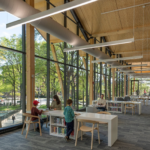Renovating a commercial space can breathe new life into a business, improve customer experience, and enhance operational efficiency—but when your business can’t afford to shut down, renovations can feel like a logistical nightmare. Whether you manage a retail store, office building, or healthcare clinic, it’s possible to renovate without halting operations—if you have the right plan and the right partner.
At Stonewing Builders, we specialize in phased remodelling—a strategic approach that allows businesses to operate safely and productively during renovations. This article explores practical tips and proven strategies for completing commercial renovations without disrupting day-to-day business. We’ll also share real-world examples, ideal phasing techniques, and how thoughtful scheduling and communication can make your remodel a success.
What Is Phased Remodelling?
Phased remodelling is a construction strategy where the renovation is broken into multiple segments or “phases” to accommodate the clients busy schedule. Each phase is completed independently, allowing parts of your business to remain operational while others are under construction.
Key Benefits:
- Business continuity without full closure
- Maintains staff productivity and customer service
- Minimizes revenue loss
- Improves safety and reduces liability
- Increases project flexibility for timing and logistical adjustments
Industries That Benefit from Phased Remodelling:
Phased remodelling is especially beneficial for businesses that can’t afford downtime, including:
- Medical clinics and urgent care centers
- Retail stores and grocery chains
- Corporate offices and call centers
- Financial institutions
- Schools and government buildings
- Restaurants and cafes
Each of these environments has operational, safety, and code compliance needs requiring careful planning and minimal disruption.
Step-by-Step Guide to Phased Commercial Renovations:
Step 1 – Preconstruction Planning
Early planning is everything. Before the first hammer swings, a strong strategy is needed to identify project goals, critical business hours, and sensitive work zones.
Tips:
- Conduct a facility assessment to identify constraints and opportunities
- Engage all stakeholders early including department heads, IT, and maintenance
- Schedule a discovery meeting with your contractor to discuss operational logistics
- Identify key dates or “blackout periods” (e.g., holidays, major sales events, etc.)
Step 2 – Develop a Detailed Phasing Plan
A detailed phasing plan maps out which areas will be worked on, in what order, and during what timeframes.
Phasing Plan Should Include:
- Zone layouts (e.g., reception, offices, corridors)
- Access points for staff, customers, and contractors
- Temporary relocation of desks, workstations, or checkout lanes
- Sound mitigation strategies for noise-sensitive environments
- Utility shutdown coordination (HVAC, power, plumbing)
Example: In a phased renovation of a dental clinic, waiting rooms were updated first, followed by operatories—scheduled during off-hours and weekends to keep patient appointments on track.
Step 3 – Establish Safe Work Zones
To protect employees and visitors, construction zones must be safely separated from active areas.
Key Elements:
- Temporary walls or dust barriers
- Noise and odor control (fans, filters, sealed zones)
- Clear signage directing traffic and detours
- After-hours work for high-impact tasks
- Compliance with OSHA and ADA access
Pro Tip: Use modular wall systems or zip walls to minimize setup time while maintaining professional appearance and protection.
Step 4 – Communicate, Communicate, Communicate
Communication is the glue that holds a phased remodel together. Keep everyone informed and confident throughout the process.
Best Practices:
- Post signage explaining the project timeline and affected areas
- Send weekly updates to staff or tenants via email
- Use QR codes on posters for real-time schedule access
- Hold short huddles before new phases begin
- Assign a staff liaison to work with the builder daily
Example: During a retail renovation, weekly email updates with floor plans and progress photos helped staff stay informed and enthusiastic, even during disruptions.
Step 5 – Stay Flexible with Scheduling
Even with the best planning, renovations can hit speed bumps—supply delays, weather issues, or code inspections. Flexible scheduling keeps the project on track without upending operations.
Flexibility Tactics:
- Include buffer time between phases
- Use swing spaces to relocate staff temporarily
- Schedule inspections and noisy work outside of business hours
- Have alternate layouts ready in case work needs to shift
Tips for Specific Business Environments:
Medical Offices & Clinics
- Prioritize infection control and patient privacy
- Use HEPA filters and negative-pressure containment zones
- Phase work around patient schedules—early mornings, evenings, or weekends
- Secure storage for medical equipment and pharmaceuticals
Retail & Customer-Facing Spaces
- Maintain visible signage and open entrances
- Use decorative barriers that match your branding
- Always keep checkout counters and footpaths functional
- Protect merchandise from dust and debris
Corporate Offices
- Relocate departments in phases
- Use temporary cubicles or shared meeting rooms as overflow
- Coordinate IT shutdowns during off-hours
- Set up alternative work-from-home options if needed
Real-World Example: Office Renovation Without Downtime
A regional insurance company in Minnesota needed to modernize its 12,000 sq. ft. headquarters—without interrupting operations. Stonewing Builders developed a 4-phase plan:
- Phase 1: Lobby & Reception – After-hours work with temporary customer entrance
- Phase 2: Admin Wing – Staff temporarily relocated to break rooms
- Phase 3: Executive Offices – Custom modular partitions and sound control
- Phase 4: Conference & Restrooms – Weekends only, with on-site porta-units
The result? A complete interior upgrade without missing a single workday or customer appointment.
Materials and Techniques for Cleaner Construction:
Certain tools and materials are ideal for occupied-space construction:
- Low-VOC paints and adhesives
- Prefabricated wall assemblies
- Self-contained HEPA-filtered equipment
- Cordless, dust-minimizing tools
- Quick-curing compounds (reduces drying and ventilation time)
These tools ensure that remodelling doesn’t compromise indoor air quality, comfort, or safety.
Why Choose the Right Contractor for Phased Projects:
Phased remodels are complex. They demand logistical coordination, attention to detail, and an understanding of your business needs. Your contractor must not only be skilled in construction, but also in project management, safety, communication, and flexibility.
What to Look for:
- Experience working in occupied spaces
- References from similar industries
- Willingness to build and revise phasing plans
- A strong safety track record and insurance
- Clean, courteous, and communicative crews
At stonewingbuilders.pro, we’re experienced in delivering remodels that respect your business and your people. With a no-fail work ethic and over 20 years of success, we know how to complete beautiful renovations—without missing a beat.
Final Thoughts – Build Smarter, Without Slowing Down:
Renovating your workplace shouldn’t mean closing your doors. With a smart, phased approach, you can modernize, expand, and improve your commercial space—without halting operations or sacrificing revenue.
Whether you’re upgrading a medical office, refreshing a retail space, or remodelling a busy headquarters, phased remodelling lets you build with minimal disruption and maximum impact.
The key? Plan early, communicate constantly, and partner with a contractor who understands your mission.
Summary – Key Tips for Disruption-Free Commercial Renovations:
- Plan early and involve all departments
- Create a clear and realistic phasing plan
- Isolate active work areas safely and visibly
- Keep staff and customers informed weekly
- Use cleaner materials and smarter tools
- Work flexibly around your business schedule
- Hire a contractor experienced in phased remodelling








